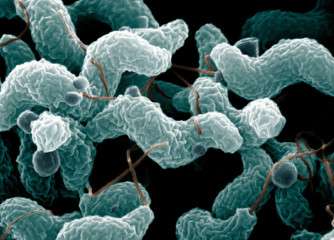Slow headway for food safety

(Medical Xpress)—Despite the availability of new and preventive methods against foodborne diseases, their uptake throughout the entire chain of food production appears to be slow.
Several hundred thousands of Europeans are affected by food borne diseases every year. Only a shift in perception of how food safety should be achieved could help avoid these illnesses. This is according to scientists from a large-scale European research project called PathogenCombat. They recommended that new, preventive methods, developed by the project, be applied in the entire chain of food production, when the project was completed in 2010. However, almost three years on, the level of uptake of these methods among food professionals is unclear.
The project developed a number of new methods to detect, predict and characterise emerging pathogens along the food chain. The eight pathogens studied, include bacteria such as Listeria and Campylobacter jejuni, Staphylococcus aureus, invasive variants of the yeast Saccharomyces cerevisiae, and the hepatitis E virus as well as the tickborne encephalitis virus.
"Previously the detection of pathogens was almost entirely based on cultivating bacteria extracted from the food, "says Mogens Jakobsen, project coordinator and professor emeritus at the Department of Food Science, University of Copenhagen, Denmark. He adds: "We developed methods to directly extract DNA and RNA from the food bacteria and in this way we can find out if the food contains pathogens in a much easier and fast way."
Independent food safety experts have welcomed the outcome of PathogenCombat. "The project has generated important science based knowledge that can be used around the world to better prepare processed and preserved food such that incidents of foodborne diseases can be reduced," Larry Beuchat from the Department of Food Science and Technology, University of Georgia, Athens, USA, tells youris.com.
However, a change in perception of how food safety should be achieved is required. "Traditionally food safety has been seen as a matter of control and testing," says Jakobsen, "but our research shows that safe food and appropriate consumer protection can only be assured if we apply preventive measures in the entire food chain."
Other food safety experts concur. "It's impossible to hire thousands of people to do testing on every piece of food sold in Europe," says Jeffrey Hoorfar, professor at the Division of Food Microbiology at the Danish Technical University in Lyngby, who did not participate in the project. "But it doesn't take a lot to arrange food production in a safe way that can prevent the food from being contaminated." Hoorfar is the leader of another EU funded project, called BioTracer, which is aimed at preventing pathogens from contaminating meat in factories.
Hoorfar also believes that the project has "done a great job identifying the right safety procedures and give guidance to food producing companies." However, it is unclear when the new prevention technologies and safety procedures will be fully implemented in the food chain. "We have no information on the extent to which the methods and procedures developed have been taken up by industries and regulatory agencies to improve risk management," concludes Mogens Jakobsen. Full adaption may take a while, yet. "This will happen, but unfortunately it's a very slow process."
















